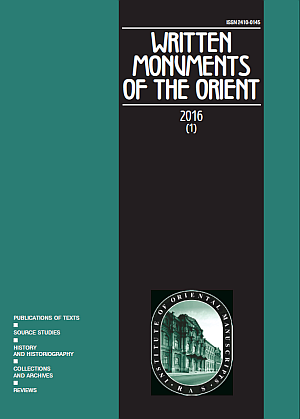Том 2, № 1 (2016)
- Год: 2016
- Выпуск опубликован: 15.06.2016
- Статей: 11
- URL: https://journals.eco-vector.com/2410-0145/issue/view/1408
- DOI: https://doi.org/10.17816/wmo.21
Статьи
The Buddhastotra of the Petrovskii Collection
Аннотация
The article is devoted to the publication of two leaves of a manuscript in Tocharian B from the Petrovskii collection, which is kept in the Institute of Oriental Manuscripts of the Russian Academy of Sciences, in St. Petersburg, known under the call numbers SI P/1b (SI 1903) and SI P/2b (SI 1904). These two leaves are consecutive and almost complete. The text is being published here for the first time in its entirety, with full transliteration, transcription and translation. It is part of a Buddhastotra, a poem of praise addressed to the Buddha, the stanzas of which are parallel to several stanzas of the Varṇārhavarastotra by Mātrceṭa.
Written Monuments of the Orient. 2016;2(1):3-20
 3-20
3-20


Manuscripts of the Mahāparinirvāṇa-mahāsūtra from Dunhuang: Preliminary Arrangement According to its Scroll Division
Аннотация
The paper considers one of the methods of manuscript classification applied to the Chinese translation of Mahāparinirvāṇa-mahāsūtra from Dunhuang. Given the fact that the beginnings and endings of some scrolls of its different versions do not correspond, researchers identify several types of scroll division (fen juan 分卷). This paper attempts to reconstruct one of these types based on Daboniepanjing chao 大般涅槃經鈔 (“Digests of the Mahāparinirvāṇa-mahāsūtra”) manuscripts from Dunhuang.
Written Monuments of the Orient. 2016;2(1):21-34
 21-34
21-34


The Canons of the First Ecumenical Council of Nicaea in the Manuscript IOM, RAS Syr. 34
Аннотация
The article deals with the manuscript IOM, RAS Syr. 34, one leaf of parchment originating from the collection of Nikolai Likhachev. It contains a Syriac translation of selected documents of the First Ecumenical Council of Nicaea (AD 325): the introduction to the canons, a bilingual Greek-Syriac list of 42 bishops, and the first five canons of the council. Most of the texts are incomplete and damaged. The present article focuses mainly on the study and commented publication of the five Nicaean canons from IOM, RAS Syr. 34. On the basis of comparative textual research the author aims to show the place of the St. Petersburg manuscript in the history of Syriac translations of the canons.
Written Monuments of the Orient. 2016;2(1):35-63
 35-63
35-63


An Old Uighur Fictional Letter Supposedly Written by Prince Gautama from a Fragment in the Serindia Collection at the IOM, RAS
Аннотация
In this paper the Old Uighur fragment SI 4bKr 11 (SI 4028) of the Serindia Collection at the Institute of Oriental Manuscripts, the Russian Academy of Sciences is edited together with notes. Its content are rather peculiar and shed some light on the attitude of Uighur monks towards their Buddhism.
Written Monuments of the Orient. 2016;2(1):64-72
 64-72
64-72


The Pahlavi Lapidary
Аннотация
The text “The Pahlavi Lapidary” is difficult for translation and interpretation because different properties are attributed to stones of the same colour and the same properties to stones of different colours. Correct translation of Pahl. sāyišn as a concrete noun ‘a powder’ appears to explain the lapidary and to show that it is not only a question of stones of different colours, but of different coloured powders of these stones. Pahl. muhrag used not in its meaning of ‘a seal’, but in the meaning ‘a stone’ appears to suggest that this text may have been translated from a language in which there is one noun for these two meanings.
Written Monuments of the Orient. 2016;2(1):73-84
 73-84
73-84


Mongolian Golden Kanjur Fragments in the Collection of the IOM, RAS
Аннотация
The collection of the IOM, RAS contains a number of odd folios from the Mongolian Kanjur, the history of whose entry into the collection is unknown. The text is written in golden ink on blue paper. Handwriting and orthography are characteristic of the first half of the 17th c. Appearance and ductus reveal a striking similarity to the Golden Kanjur of Ligdan Khan kept in Hohhot. In the article the folios from IOM, RAS are compared with the Golden Kanjur. An attempt to trace back the history of these manuscript fragments leads to the conclusion that they could be among the first Mongolian manuscripts brought to St. Petersburg at the time of Peter the Great.
Written Monuments of the Orient. 2016;2(1):85-105
 85-105
85-105


The Manuscript Nijūgokoku chūka chikyū no zu (“Pictures of the Peoples of Twenty Five Countries with Maps of China and the World”) in the IOM, RAS Collection
Аннотация
The article introduces a Japanese manuscript containing maps of China and the world along with depictions of the inhabitants of 25 countries and brief descriptions of those countries. On the basis of the information about Russia and the Ainu lands, the author puts forward a hypothesis about the date of the manuscript.
Written Monuments of the Orient. 2016;2(1):106-110
 106-110
106-110


Shimon Yakerson. Ozar Sepharad - Sefardskaia sokrovishchnitsa. Sefardskaia kniga X-XV vv. Ot rukopisnoi k pechatnoi traditsii. [Ozar Sepharad: Sephardic treasury. Sephardic Books from the Tenth to the Fifteenth Century. From Manuscripts to Printed Books] - St. Petersburg: Filologicheskii fakul’tet SPb. gosudarstvennogo universiteta, 2015. - 127 pp
Written Monuments of the Orient. 2016;2(1):111-112
 111-112
111-112


“Vtoroi” i “Tretii” al’bomy o. Iakinfa (N.Ya. Bichurina) [The “Second” and “Third” Albums of Fr. Iakinf (N.Ya. Bichurin)] / Introduction by Academician V.S. Miasnikov and O.V. Vassilieva. Publication by O.V. Vassilieva - St. Petersburg: National Library of Russia, 2012. - 56 pp. + 58 pp. of facsimiles (Nontraditional sources on the history of China during the Qing Dynasty (1644-1911)
Written Monuments of the Orient. 2016;2(1):113-114
 113-114
113-114


A. Helman-Ważny. The Archaeology of Tibetan Books. Leiden-Boston: Brill, 2014. - 311 p. Brill’s Tibetan Studies Library. Ed. by H. Blezer, A. McKay, Ch. Ramble. Vol. 36
Written Monuments of the Orient. 2016;2(1):115-117
 115-117
115-117


Arakawa Shintarō 荒川慎太郎. Seika bun Konggo kyō no kenkyū (西夏文金剛經の研究). - Kyōto: Shoukadoh, 2014
Written Monuments of the Orient. 2016;2(1):118-125
 118-125
118-125












